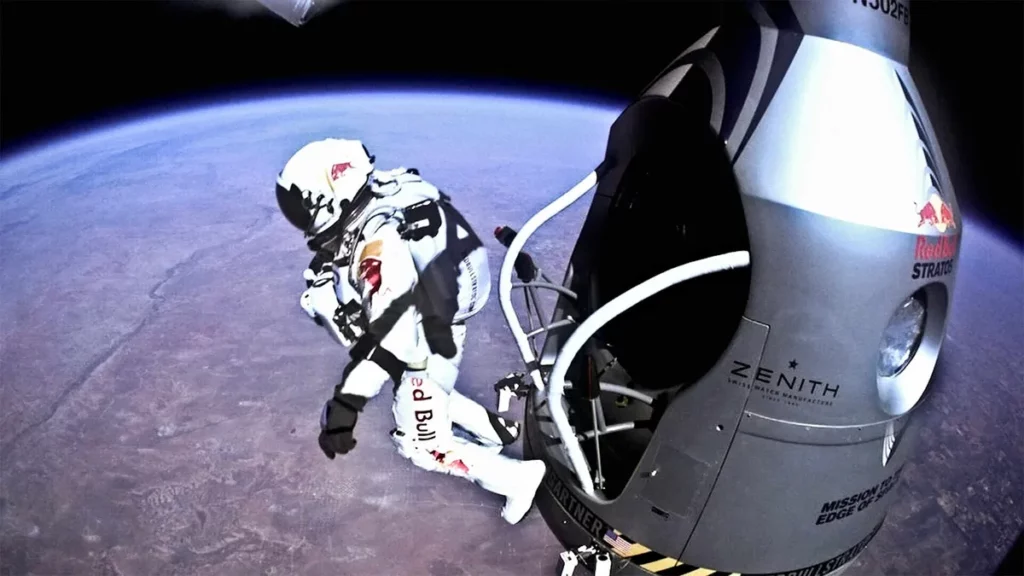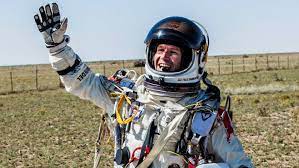On August 16, 1960, Air Force Captain Joe Kittinger Jr. jumped from a gondola attached to a helium balloon 102,800 feet above the ground.
The free fall lasted four minutes and 36 seconds at 102,800 feet (31,333 meters), with Kittinger traveling at more than 600 mph (966 km/h) before he opened his parachute at about 14,000 feet (4,267 meters).
Fifty-two years later, on October 14, 2012, Austrian skydiver and daredevil Felix Baumgartner traveled to the edge of space, 127,852 feet (38,969 m) above Earth in a capsule under a helium balloon on a Red Bull Stratos mission.
He free fell a record 119,31 feet (36,03 m), breaking Kittinger’s record and breaking the sound barrier (Mach 1.25). He was watched by millions of people live on television. His parachute flew 8400 feet (2,560 meters), and he landed safely.

Ten years later, Red Bull released the 10th-anniversary documentary “SPACE JUMP: How Red Bull Stratos captured the world’s attention with unprecedented images and perspectives, celebrating one man’s rigor and mission legacy.” The project, which was supposed to take two months, ended up taking several years.
“We thought we would build a capsule, build a pressure suit, train for a while, and then go up to the stratosphere and come back to Earth at supersonic speed,” Baumgartner told CNN.
Ultimately, the stunt had a major impact on the world and science, “including important insights into the space program and space technology,” the press release said.
“Its global impact on education and the next generation of aspiring aeronautical or flight test engineers has been enormous,” said Art Thompson, technical project manager, in a statement. “In addition to the life support system designed for the capsule, we used this technology and data to modify the rescue configuration of [high-altitude aircraft, including] the U-2.”

In an interview Baumgartner said, “I think it’s interesting that even ten years from now, there’s so much enthusiasm and recognition and respect for what we’ve accomplished.
It means we did something right. ” Forbes reporter Jim Clash bravely asked what the view was like from the edge of space. Baumgartner said: “The sky goes really black. You’ve left the atmosphere and you’re in the stratosphere. It’s a very unforgiving and hostile environment. Do you spin Can you stop it? What happens when you go superhuman? A vision is one thing, all the unanswered questions are another. So you get out, accelerate like crazy into the unknown and see what happens. ”
Moments after Baumgartner’s free fall, as he accelerated to the speed of sound, the skydiver continued his rapid horizontal rotation. Such a rotation can cause loss of consciousness as a result of which the parachutist cannot retract the parachute.
Fortunately, Baumgartner had made some jumps at lower altitudes and was experienced. He regained consciousness in time, got off the ridge, and pulled the chute to safety. “When I opened my parachute and opened my visor, I breathed outside air for the first time in seven hours. I have connected to the outside world again, and it was a very happy moment. The only thing I didn’t know when I landed was: did I break the speed of sound?
Because when you’re in free fall, you know you’re fast, but you don’t know how fast you really are, “he said.
Baumgartner has been piloting a stunt helicopter at air shows since Mission and has continued to perform his basic jump stunts. Today, he is one of the few aerobatic pilots in the world.
There is nothing else in the world that makes a fool feel more alive.




